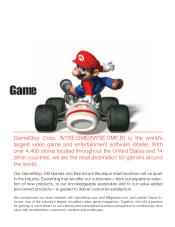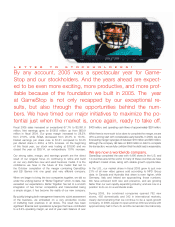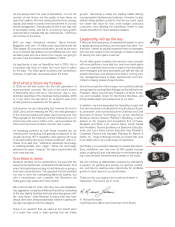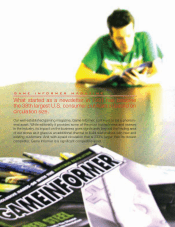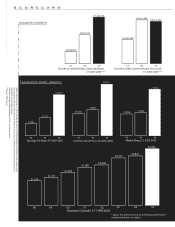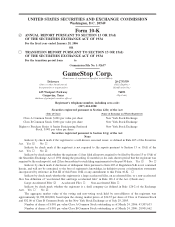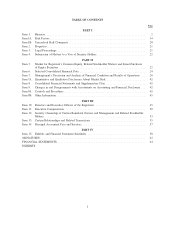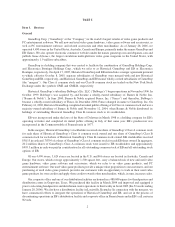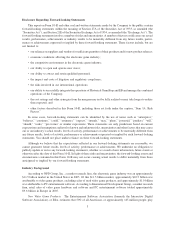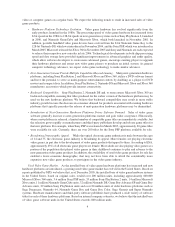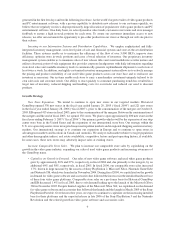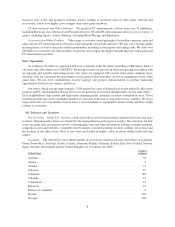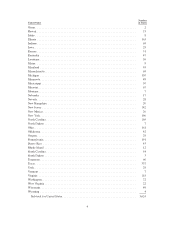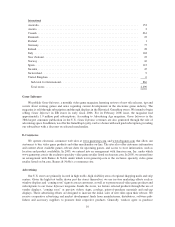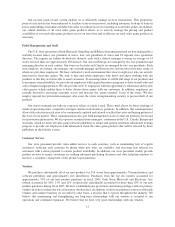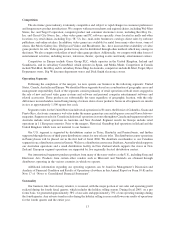GameStop 2005 Annual Report Download - page 12
Download and view the complete annual report
Please find page 12 of the 2005 GameStop annual report below. You can navigate through the pages in the report by either clicking on the pages listed below, or by using the keyword search tool below to find specific information within the annual report.Disclosure Regarding Forward-looking Statements
This report on Form 10-K and other oral and written statements made by the Company to the public contain
forward-looking statements within the meaning of Section 27A of the Securities Act of 1933, as amended (the
“Securities Act”), and Section 21E of the Securities Exchange Act of 1934, as amended (the “Exchange Act”). The
forward-looking statements involve a number of risks and uncertainties. A number of factors could cause our actual
results, performance, achievements or industry results to be materially different from any future results, perfor-
mance or achievements expressed or implied by these forward-looking statements. These factors include, but are
not limited to:
• our reliance on suppliers and vendors for sufficient quantities of their products and for new product releases;
• economic conditions affecting the electronic game industry;
• the competitive environment in the electronic game industry;
• our ability to open and operate new stores;
• our ability to attract and retain qualified personnel;
• the impact and costs of litigation and regulatory compliance;
• the risks involved in our international operations;
• our ability to successfully integrate the operations of Historical GameStop and EB and manage the combined
operations of the Company;
• the cost savings and other synergies from the mergers may not be fully realized or may take longer to realize
than expected; and
• other factors described in this Form 10-K, including those set forth under the caption, “Item 1A. Risk
Factors.”
In some cases, forward-looking statements can be identified by the use of terms such as “anticipates,”
“believes,” “continues,” “could,” “estimates,” “expects,” “intends,” “may,” “plans,” “potential,” “predicts,” “will,”
“should,” “seeks,” “pro forma” or similar expressions. These statements are only predictions based on current
expectations and assumptions and involve known and unknown risks, uncertainties and other factors that may cause
our or our industry’s actual results, levels of activity, performance or achievements to be materially different from
any future results, levels of activity, performance or achievements expressed or implied by such forward-looking
statements. You should not place undue reliance on these forward-looking statements.
Although we believe that the expectations reflected in our forward-looking statements are reasonable, we
cannot guarantee future results, levels of activity, performance or achievements. We undertake no obligation to
publicly update or revise any forward-looking statements, whether as a result of new information, future events or
otherwise after the date of this Form 10-K. In light of these risks and uncertainties, the forward-looking events and
circumstances contained in this Form 10-K may not occur, causing actual results to differ materially from those
anticipated or implied by our forward-looking statements.
Industry Background
According to NPD Group, Inc., a market research firm, the electronic game industry was an approximately
$11.5 billion market in the United States in 2005. Of this $11.5 billion market, approximately $10.5 billion was
attributable to video game products, excluding sales of used video game products, and approximately $1.0 billion
was attributable to PC entertainment software. According to International Development Group, a market research
firm, retail sales of video game hardware and software and PC entertainment software totaled approximately
$9.6 billion in Europe in 2005.
New Video Game Products. The Entertainment Software Association (formerly the Interactive Digital
Software Association), or ESA, estimates that 50% of all Americans, or approximately 145 million people, play
3



